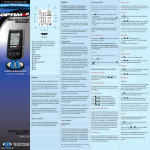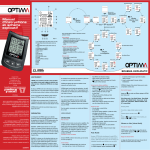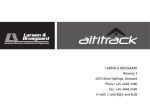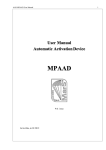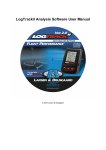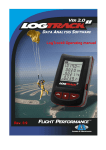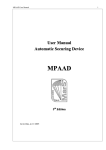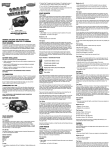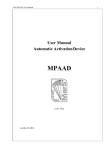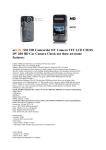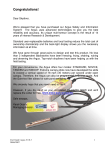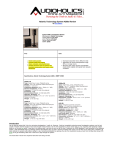Download MANUAL & ROAD MAP - Larsen & Brusgaard
Transcript
2nd. warning altitude 3rd. warning altitude Power ON Press and hold any key for 5 sec. Set time Instruction Clock selector MANUAL & ROAD MAP 1st. warning altitude Main window Low Speed Warnings selector Perform ACCESS Perform ACCESS Clock Guide Low speed Perform ACCESS Sound test Warning Banks Figure 1 1st. warning altitude (1st. low speed alarm) 2nd. warning altitude (2nd. low speed alarm) 3rd. warning alarm (3rd. low speed alarm) Perform ACCESS Warning bank Pitch OFF Battery status Lo speed status Alarm sounds FT/MTR Altitude/altitude offset Clock Up Mode Down 1st. warning altitude The Main Display has the following characteristics by default (normal usage): Altitude area: - Displays current altitude – which is normally zero unless jumping into a DZ with a different altitude than the takeoff airport - Displays the altitude units-of-measure (either meters or feet) Warning bank area: - Displays the active freefall warning bank altitudes - Displays Pitch - Displays the Ear icon - Displays the GUIDE and LO SPD icons if they have been activated Icon area - Padlock icon – used to indicate and control entrance to ACCESS mode - Warning bank icon – this has a number in front of it to indicate which of the four freefall warning banks is being displayed - OFF icon - is used to manually power OFF the Optima - Battery Power Level icon – indicates the remaining battery power or Switch off 2nd. warning altitude and Setup selector Altitude offset 3rd. warning altitude FT/MTR Pitch Sound test ROAD MAP or Mosevej 3 4070 Kirke Hyllinge, Denmark Phone: +45 46 48 24 80 Fax: +45 46 48 24 90 E-mail: [email protected] www.L-and-B.dk WARNING! The OPTIMA is intended to be a backup device and must not be relied upon as your primary means of maintaining altitude awareness. Use the OPTIMA at your own risk. bient air pressure and temperature and adjusts the electronic circuitry to the local elevation. The thin and ergonomic design ensures a perfect and comfortable fit to your ear when placed in your fraphat or hard helmet. Do not put the OPTIMA directly next to your ear when testing the alarm sounds on the ground, as the OPTIMA alarm volume is very loud. It may cause pain or damage to the ear. The OPTIMA can be mounted on the outside of any type of helmet by means of the enclosed ties. Due to outside wind noise in freefall, the alarm sounds will not be perceived to be as loud as when testing the OPTIMA on the ground. The OPTIMA is ideally suited for Relative Work, Skysurfing, Freeflying, Wing Suit Flying, Student, Tandem, AFF, and also canopy related activities such as accuracy, Crew and swooping. If the OPTIMA is not mounted correctly, you may not hear the alarm sounds in freefall. Make sure the OPTIMA is mounted correctly before you jump. We hope you will enjoy jumping with your new OPTIMA. The OPTIMA must be active (powered on) prior to entering the airplane. INTRODUCTION Congratulations on purchasing your new OPTIMA! The OPTIMA design is based upon the latest findings in microcomputer technology and freefall parameters and now provides four warning banks (four sets of warning altitudes) to provide added flexibility in configuring frequently used freefall warning alarms. NEW!! The OPTIMA introduces a new class of warnings for use by skydivers – Canopy Descent Warnings and landing Guide Tones. These allow you to preset warning altitudes for use under canopy and, if desired, to provide timing beeps to help you track your landing progress versus your altitude during the semi-final stage of your canopy descent. Manufactured by: The buyer and user of the OPTIMA indemnify the manufacturer and vendor from any liability for damage incurred before, during and after skydiving with the instrument. Waiver of Liability All further claims, especially for defects after skydiving accidents, are excluded. LARSEN & BRUSGAARD has no obligation to honour any extension of warranty granted by any national agent. The warranty becomes void if damage is caused by external circumstances or if the unit has been serviced or repaired by third parties unauthorized by our national agents or LARSEN & BRUSGAARD. To make a claim under this warranty, send the unit to an authorized dealer or directly to LARSEN & BRUSGAARD together with the dated purchase invoice or receipt. Within 12 months after delivery, damage or defects in the unit that are proven to be caused by faulty manufacture will be repaired by LARSEN & BRUSGAARD at no cost to the end user. The following conditions apply to the OPTIMA warranty: NOTE: The Canopy Descent Alerts are essentially low speed alerts and can also be used by wing suit flyers to keep track of altitude in preparation for separation and canopy deployment. WARRANTY The OPTIMA is fully automatic. It continually records the am- Please read ALL of the instructions below prior to actual skydiving use. It is a very good idea to practice ACCESSing the OPTIMA and setting the warning values on the ground prior to your first jump with the OPTIMA. If you have any questions please call, fax or e-mail us. LARSEN & BRUSGAARD INSTRUCTIONS Power ON The OPTIMA has been powered off prior to shipping from our factory. To turn the power on, press and hold any key until the unit beeps, then release the button. The OPTIMA runs a self-test and sounds three beeps as it flashes the screen three times. It then displays a screen configuration referred to henceforth as the “Main Display.” This represents the starting point for all further actions with respect to OPTIMA actions and subsequent displays. Altitude area: - Displays current altitude – which is normally zero unless you have previously jumped into a DZ with a different altitude than the takeoff airport altitude - Displays the altitude units-of-measure (either meters or feet) - Also displays time-of-day clock when the button is pressed from the Main Display Warning bank area: - Displays each of the four freefall warning banks used by the OPTIMA (warning banks 1-4) - Displays the canopy descent warnings when the button is pressed from the Main Display. - Displays the tone bar graph for adjusting the pitch of warning sounds - Displays the Ear icon for use in opting to sound test alarms - Displays the GUIDE icon to indicate that Guide Tones are active - Displays the LO SPD icon to indicate that Canopy Descent Warnings (Low Speed Warnings) are active Icon area: - Padlock icon – used to indicate and control entrance to ACCESS mode - Warning bank icon – this has a number in front of it to indicate which of the four warning banks is being displayed or modified (the canopy descent warnings are accessed in a different manner than the 4 freefall warning banks – see chapter for details) - Musical Note icon – used to indicate that you are in audio frequency select mode - Off icon – when flashing, is used to manually POWER OFF the OPTIMA - Battery Power Level icon – indicates the remaining batery power Power ON) can be performed ONLY when the OPTIMA is in ACCESS mode. 1.Press and release quickly – the padlock icon turns off (disappears) 2. When the padlock icon reappears, immediately press and keep it pressed – the padlock icon will disappear again 3. When the padlock icon appears again, release im mediately The OPTIMA now flashes the warning bank icon with a number in front of it to indicate the active warning bank number. Menu Function Sequence By repeatedly pressing the OPTIMA scrolls through the menu functions in this order: For the active warning bank: 1st warning altitude - 2nd warning altitude - 3rd warning altitude; sound pitch; test alarm sounds; feet/meters; altitude offset; OFF icon; Main Display. General Note: To leave a menu function, wait until the display times out, or, press and hold for 5 sec., or, press repeatedly until the padlock icon flashes, then press or to exit Freefall (High Speed) Warnings Warning Bank Menu Functions OPTIMIA Screen Layout Performing ACCESS The OPTIMA screen is divided into three sections, which are, from top-to-bottom (refer to Figure 1): Note: The OPTIMA goes out of ACCESS and back to the Main Display if no button has been pressed within 5 sec. ALL functions (except The OPTIMA has 4 freefall warning banks. When the warning bank icon is flashing, press or to select warning bank 1 to 4. Setting the Warning Altitudes The setting of altitudes in each warning bank can be performed either on the ground or in the airplane during climb to jump altitude. Jump Mode and retains the altitude offset for 5 hours, if no jump is made. After 5 hours the OPTIMA recalibrates to the field elevation where it is currently located and once again displays 0. The altitude offset is not retained when the OPTIMA is powered OFF. Power OFF Function Three Warning Alarms 1. Press 2. Press 3. Press 4. Press 5. Press 6. Press until 1st warning altitude flashes or to change 1st warning altitude again and the second warning altitude flashes or to change 2nd warning altitude again and the third warning altitude flashes or to change 3rd warning altitude The OPTIMA can be manually powered OFF to further extend the battery life time when not in use. Press again. The OFF icon in the icon area of the Main Display will begin to flash. Press and hold both and until the display flashes, then release. The OPTIMA will shut off. Sequence of Warning Alarm Altitudes You may note that when setting the warning altitudes, it is possible to set the 1st warning alarm altitude lower than the second or even the 3rd warning altitudes. The 2nd warning altitude could be set to a higher value than the 1st warning altitude or a lower value than the 3rd warning altitude, and so on. This is not a problem – when the OPTIMA exits ACCESS mode, it will automatically sort and store the warning alarms such that the highest warning altitude become the 1st warning alarm, the next highest warning altitude becomes the 2nd warning alarm, and the lowest warning altitude becomes the 3rd warning alarm. Customer settings (except altitude offset) are stored in nonvolatile memory when the OPTIMA is powered OFF. Note: For safety reasons, the minimum selectable swoop height is 300 ft.(90 meter) and the minimum selectable altitude difference between the 2nd and 3rd warnings is 300 ft.(90 meters). Note: For more information please see, www.L-and-B.dk/articles/ Optima To enable Guide Tones Time Set Function Press repeatedly until GUIDE flashes. Press until the GUIDE icon is on. Built-in clock In Main Display mode, press to display the time. The time is in 24-hour format. The time is displayed for 15 seconds and then reverts back to the Main Display. Setting the time: If you choose, you may have only two warning alarms. The procedure is the same as above, but choose same altitude for the two highest warning alarms (the OPTIMA then sounds only the 2nd and 3rd warning alarms). Perform ACCESS and press or to set the time. Canopy Descent (Low Speed) Warnings and Guide Tones One Warning Alarm The OPTIMA includes two types of warning sounds which can be selected to sound while under canopy descent. Description or To disable Guide Tones Press repeatedly until GUIDE flashes. Press until the GUIDE icon is off. Note: If Guide Tones are enabled, the GUIDE icon will show in the warning bank area of all warning bank displays and in the Main Display. Sound Pitch Function Canopy Descent Warnings: Press again. The musical note icon and pitch bar graph will begin to flash Short beeps sound when passing through one, two or three selectable altitudes during canopy descent or winged suit flight. OPERATIONAL CONSIDERATIONS Press or to change the pitch up or down. The pitch bar graph will display the number of bars corresponding to the selected pitch and the selected pitch will sound. Guide Tones: Prior to Jumping Note: When selecting a pitch on either side of the center vertical bar (3,800 Hz), the output volume decreases about 5 dB because the speaker is no longer at its optimum resonance frequency. Setting Canopy Descent Warnings Note: Minimum selectable low speed height is 300 ft (90 meters) Trouble-shooting When the OPTIMA detects a fault, an error (“ERR”) sign and trouble shooting number 2 to 4 are displayed in the upper part of the screen. At the same time the unit beeps every minute. At 1,000 feet +/-100 feet, the OPTIMA sounds a sequence of beeps. These beeps have two functions: 1. The beeps indicate that the OPTIMA has calibrated itself to the local ground elevation and is ready to jump. 2. The number of beeps indicates the altitude at which the highest warning alarm is set; for example: If set to 5,500 feet, the signal will sound: beep-beep-beep-beep-beep(pause)-beep. The number of rapid-sequence of beeps indicates the highest warning altitude in thousands of feet. The beep after a pause (if any), signifies a 500-foot altitude increment. again. The ear icon will begin to flash. Press or . This causes the OPTIMA to sound the preset alarm sequence at the selected pitch. Note: From the factory, default values 1200 ft., 900 ft., and 600 ft. have been set for Canopy Descent (Low Speed) Warning altitudes. In the Main Display mode, press to access the Canopy Descent Warnings (Low Speed Warnings). Press again. The FT or MT indicator located in the altitude area of the Main Display will begin to flash. Press or to switch between feet (FT) or meters (MT). Altitude Offset Function If the DZ elevation differs from that of the airport, use the altitude offset capability to set the DZ elevation prior to entering the airplane or set the altitude offset to zero when climbing through the DZ elevation. Press again. The displayed altitude (normally 0) in front of the FT or MT indicator will begin to flash. If the unit is still faulty, please contact your local dealer or LARSEN & BRUSGAARD. Weight: 26 grams (0.9 oz.) The OPTIMA can be mounted on the outside of the helmet or on a Goggle Mount. Battery type: 2 x CR 2325 or equivalent Loop the waxed tack cords through the four mounting holes and fasten with knobs to the helmet/Goggle Mount Battery Life Time: 2.5 years or 500 jumps Freefall alarm sounds: Note: Make sure that there is no material between the OPTIMA loudspeaker hole and your ear. One 3 second pulsating alarm if vertical airspeed exceeds 13 m/ sec at preset altitude. Sound sequence: Pulsating, low repetition. Resetting the OPTIMA 2nd warning: 1st warning: One 4 second pulsating alarm if vertical airspeed exceeds 13 m/sec at preset altitude. Sound sequence: Pulsating, high repetition. 3rd warning: Siren alarm as long as vertical airspeed exceeds 13 m/sec at or below the preset altitude. After deployment the trigger speed switches to 35 m/sec. Sound sequence: High pitch continuous siren. Press a paperclip into the tiny hole on the side of the unit and release. The unit restarts. Note: Reset the unit after battery replacement, when troubleshooting and when verifying software version number. Low Speed alarm sounds: 1st warning: One 0.2 second beep 2nd warning: Two 0.2 second beeps 3rd warning: One 1.3 second beep Battery Status Note: When Canopy Descent (Low Speed) Warnings are enabled, the LO SPD icon will show in the warning bank area of all warning bank displays and in the Main Display. To disable LO SPD, set all warnings to - - - Low capacity: Symbol shows no black bars, just an “empty” battery icon. Batteries should be replaced as soon as possible. As a reminder, 5 short beeps sound when climbing through 1,000 feet. Low speed alarm calibration range: 300 to 9,990 feet (90 to 3,330 meters) Setting Guide Tones Explanation: Feet Empty batteries: The battery icon flashes. Replace batteries immediately. Operating altitude: 0 to 40,000 feet OPTIMA Firmware Version Full capacity: Symbol shows two black bars inside the battery icon. Half capacity: Symbol shows one black bar inside the battery icon. Perform reset. The version number is displayed at the upper part of the screen (altitude area). The numbers displayed in the middle of the screen is a factory reference number. 33 .5 Alarm output volume: 120 dB at maximum pitch 115 dB at minimum pitch Freefall alarm calibration range: 1,000 to 9,990 feet (300 to 3,330 meters) Altitude selection interval: 10 feet (10 meters) Accuracy: ± 20 feet (+/- 6 meters) at MSL 1500 Operating Temperature Range: -20° C to +50° C (-4° F to +122° F) fps s fp 300 Time 0 Note: When performing manual altitude offset the OPTIMA enters The OPTIMA resets to factory settings and sounds three beeps. Perform ACCESS 1. Press until 1st warning altitude flashes 2. Press or to change 1st warning altitude 3. Press again and the second warning altitude flashes 4. Press or to change 2nd warning altitude 5. Press again and the third warning altitude flashes 6. Press or to change 3rd warning altitude 16 Press or to set an altitude offset to match the altitude of the landing DZ relative to the takeoff airport. and hold while resetting. Mounting the OPTIMA Battery replacement Explanation: Press Dimensions: 52 x 40 x 12 mm (2.16 x 1.57 x 0.47 inches) Setting an Altitude Offset Feet/Meters Function If the unit does not function correctly even after replacing batteries and pressing reset, perform following: When the aircraft begins climbing to altitude, the OPTIMA displays the current altitude at the top of the display. The OPTIMA continually adjusts to the local elevation and displays 0 FT (MT) at the top of the display. If the top of the display does not show “0” (or your selected altitude offset) prior to jumping, the unit has not adjusted itself to the local elevation and it must be manually zeroed. See the section, “Altitude Offset Function” under Menu functions above. If the drop zone (DZ) elevation is different from that of the take-off airport, you may compensate for this difference by setting an Altitude Offset – see the Altitude Offset menu function described above. ERR 2, ERR 3, ERR 4 = unit is defective. Remedy: perform reset SPECIFICATIONS Test Warning Sounds Function Press The “ERR” trouble shooting codes are as follows: Should the battery voltage of the OPTIMA be low, the 1,000-foot test sequence is followed by 5 short beeps. This indicates that the batteries should be replaced. Test Alarm Sounds Press repeatedly until the ”Ear” icon flashes. Press or to sound the test Canopy Descent Warnings and Guide Tones. Note: Reset the OPTIMA after replacing batteries. Customer settings are kept in non-volatile memory when removing batteries. However, the built-in clock may again be set to the correct time. or Note: When GUIDE is enabled, a series of beeps sound simulating a 10m/sec canopy descent and when GUIDE is disabled, three warning beeps sound. A unique series of guide beeps sound when flying from the 2nd through 3rd selected Canopy Descent Warning altitudes. 1,000 Feet Test The series of beeps can be compared to an aircraft ILS approach. The first beep sounds when passing through the 2nd warning altitude, the next beep 30% into the glide corridor, then after 55% and so on as depicted in the diagram. The diagram shows an example where the 2nd warning is set to 1,500 ft and the 3rd warning to 300 ft. A long beep sounds when passing through the 3rd selected altitude. The steeper a glide angle the shorter time between beeps. When powered OFF, the OPTIMA cannot be used for jumping. Two Warning Alarms If you wish only one warning alarm, choose same altitude for all three warning alarms using the above procedure. (The unit sounds only the 3rd warning alarm). When Guide Tones are activated, a unique series of beeps sound between the 2nd and 3rd Canopy Descent Warning altitudes. 33 fps 16.5 fps Carefully slide out battery holder and remove batteries. Install new batteries using the correct polarity. Use only CR-2325 or equivalent. Meets or exceeds EEC/89/336 L&B part no.: 205220 NATO Stock no.: 6605-22-609-1694


